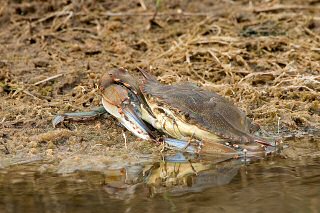|
Trail Guides
|
Commercial Township Wetland Restoration Site
|
5
 
|
Strawberry Avenue, Port Norris, NJ 08349
Phone: (888) 627-7437
www.pseg.com/environment/estuary
Public Service Enterprise Group (PSEG)
Continue down Maple St. to the
end and turn Right onto CR 553. Turn Right onto Strawberry Ave. and follow to end. The other
side of this site is accessed by a boardwalk across the street from the A.J. Meerwald office (see next page) in Bivalve. Map
Open daily from one hour before dawn to one hour after dusk. Small
parking area available on site.
 |
| Blue Crab | Bill Garwood |
| |
| | The Commercial Township Wetlands Restoration Site is part of PSE&G’s Estuary Enhancement Program. The site, an old salt hay meadow, was restored primarily to provide habitat for fish but has the added benefit of providing critical habitat for all estuarine wildlife. The site has two miles of walking trails, one leading from the town of Port Norris to Bivalve, two extensive boardwalks winding out over the newly restored marsh, an observation platform (at the Bivalve site) and a car top boat launch at nearby Robbinstown Road.
walking on the boardwalk at the end of High St. to get an elevated view of the marsh. Look down and discover the quietly teeming world that exists in the mud at ground level. Fiddler crabs, snails, mussels and insects are
visible at low tide.
Bald Eagle are frequently here in
numbers and the local peregrines often buzz
the flats looking for a meal. Red-tailed Hawk, Rough-legged Hawk and Northern Harrier are common visitors.
Early spring brings the arrival of dabbling ducks by the thousands. This is the place to brush up on your waterfowl identification skills. By May, Bivalve is truly a shorebird mecca. Not only will visitors be astounded by the numbers of shorebirds but by the variety as well. This is a great place to see unusual birds such as American Avocet and Black-necked Stilt.
Biting insects are present and sometimes overbearing so come prepared. Fall migrants are already staging in July and August and the birding can be phenomenal. Thousands of sandpipers, egrets, terns and waders feed heavily on the mudflats before venturing further south.
Fall is a great time of year to see a variety of birds at the restoration site. Look for sparrows and other passerines in the fields and along the marsh edge. Butterflies, dragonflies and
damselflies are on the move as well.
|
|
|